The Intel Core i7-12700K and Core i5-12600K Review: High Performance For the Mid-Range
by Gavin Bonshor on March 29, 2022 8:00 AM ESTGaming Performance: iGPU
All of our game testing results, including other resolutions, can be found in our benchmark database: www.anandtech.com/bench. All gaming tests here were run using integrated graphics, with a variation of 720p resolutions and at minimum settings.
We are using DDR5 memory for Alder Lake at the following settings:
- DDR5-4800(B) CL40
All of AMD's Ryzen APUs were tested with DDR4 memory at the relevant JEDEC specifications of each chip.
Final Fantasy 14
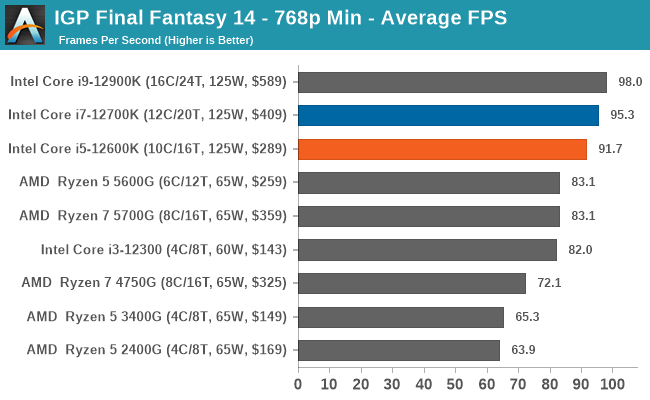
World of Tanks
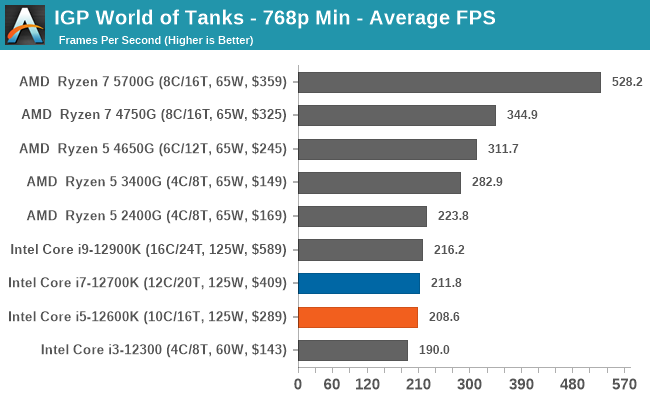
Borderlands 3

Far Cry 5

Gears Tactics
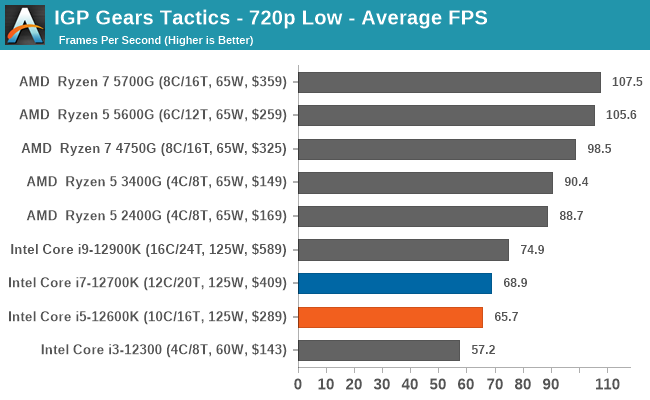
Grand Theft Auto V
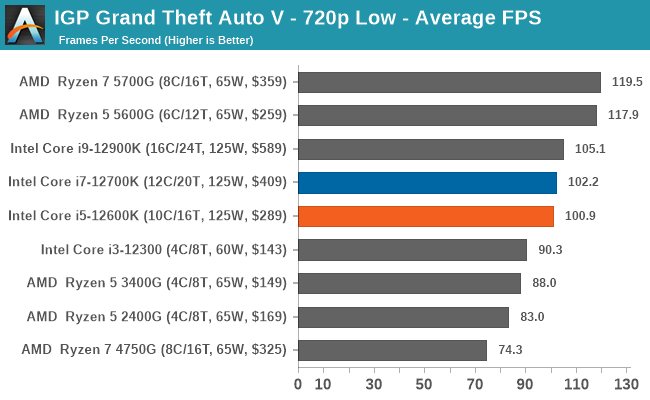
Strange Brigade (DirectX 12)
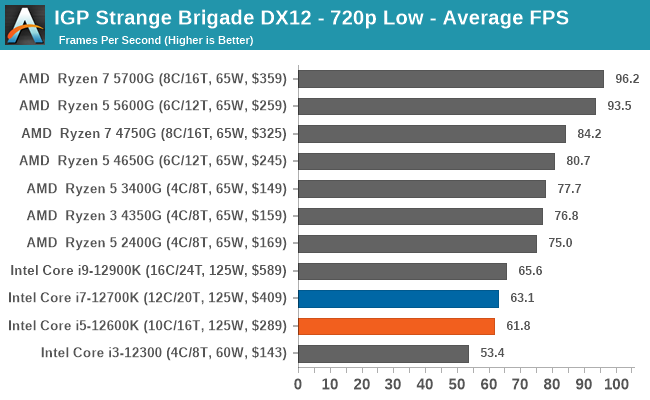
Performance on Intel's UHD 770 integrated graphics when compared to AMD's Ryzen APUs came solely down to the intensity of the game title. In scenarios where titles favor CPU grunt, the 12th Gen Core series processors did well, but when it came to graphical performance, UHD 770 clearly trails AMD's integrated Radeon graphics.
The consensus here is that in all scenarios, AMD's Ryzen APUs are superior to Intel for low-budget gaming systems where discrete graphics aren't used. Intel really only makes the bare minimum investment in die space for their iGPU here, and it shows: UHD 770 is good enough for the bare minimum in gaming, and that's about it.










196 Comments
View All Comments
Gondalf - Tuesday, March 29, 2022 - link
Beh! in short words Intel have the best 7nm (or 7nm equivalent) desktop cpu, this is pretty evident.Same applies to Mobile parts obviously. AMD approach look like rudimentary and silicon hungry versus Intel big-little silicon.
We'll see on finer nodes next year or so. Still i have the idea that Intel will never be anymore behind AMD like in past years.
eek2121 - Tuesday, March 29, 2022 - link
Keep in mind that Zen 4 is coming later this year and will make Alder Lake 2nd again. The flip/flop continues.From a technology standpoint AMD has the best setup. They can just add chiplets or cores to increase multicore performance.
They have 90-95% of the performance for less than half, or in some cases, 1/3rd the power.
Stop trolling. It makes you look immature and childish.
DannyH246 - Tuesday, March 29, 2022 - link
Yup. Completely agree, Intel are finally competitive with what? A 2yr old AMD product, but at triple the power. Yet some of the posters on here are acting like Intel are saviors who have finally returned to save us all from our PC ills. They forget that Intel literally screwed us all for a decade with high prices, feature lock outs, core counts limited to 4, new motherboards required every year, anti competitive behavior, and anti consumer practices. Why anyone would want Intel to return to the dominant position that they used to occupy is beyond me.Khanan - Tuesday, March 29, 2022 - link
Fully agree.lmcd - Tuesday, March 29, 2022 - link
Pretty delusional here -- AMD's whole plan with Bulldozer was to create vendor lock-in where you used an AMD GPU to accelerate floating point operations on an AMD CPU. Consumer-friendly to claim 4 cores are really 8? Thuban outperformed Piledriver until its instruction set finally was too limited years later. AMD just wanted a marketing point.Also, how are you playing both narratives at once? Intel both wasn't willing to deliver more than 4 cores and has too high of power consumption in its parts with more than 4 cores? Which is it? Because it quite literally cannot be both.
Samus - Wednesday, March 30, 2022 - link
OMG people are still going on about the shared FPU BS.It HAD to be that way. The entire modular architecture was built around sharing L2 and FPU's. There was nothing inherently wrong with this approach, except nobody optimized for it because it had never been done, so people like you freaked out. If you wanted your precious FPU's for each integer unit, buy something else...
Otritus - Wednesday, March 30, 2022 - link
It did NOT have to be that way. AMD intentionally chose to share the fpu and cache creating a cpu that was abysmal in performance and efficiency, and deceptive in marketing. Thuban was a better design, so updating the instruction set would have made a better product than bulldozer.I along with most people chose to buy something else (Sandybridge to Sky Lake). The lack of a competitive offering from AMD created the pseudo monopoly from Intel, and many people rightfully complained about the lack of innovation from Intel.
Also there is no optimizing for hardware that isn’t physically present. 4 fpus means 4 cpu cores when doing floating point tasks, which is highly consequential for gaming and web browsing.
There is no arguing for AMD’s construction equipment family. It sucked, just like Intel’s monopolistic dominance and Rocket Lake.
AshlayW - Wednesday, March 30, 2022 - link
FYI, most instructions in day to day workloads are integer, not floating point. Your argument that Floating point is "highly consequential" for gaming and web browsing is false.mode_13h - Thursday, March 31, 2022 - link
> most instructions in day to day workloads are integer, not floating point.Sure. Compiling code, web browsers, most javascript, typical database queries... agreed.
> Your argument that Floating point is "highly consequential" for gaming
LOL, wut? Gaming is *so* dominated by floating point that GPUs have long relegated integer arithmetic performance to little more than their fp64 throughput!
Geometry, physics, AI, ...all floating point. Even a lot of sound processing has transitioned over to floating-point! I'm struggling to think of much heavy-lifting typical games do that's *not* floating point! I mean, games that are CPU-bound in the first place - not like retro games, where the CPU is basically a non-issue.
Dolda2000 - Saturday, April 2, 2022 - link
While games certainly do use floating-point to an extent where it matters, as a (small-time) gamedev myself, I'd certainly argue that games are primarily integer-dominated. The parts that don't run on the GPU are more concerned with managing discrete states, calculating branch conditions, managing GPU memory resources, allocating and initializing objects, just managing general data structures, and so on and so forth.Again, I'm not denying that there are parts of games that are more FP-heavy, but looking at my own decompiled code, even in things like collision checking and whatnot, even in the FP-heavy leaf functions, the FP instructions are intermingled with a comparable amount of integer instructions just for, you know, load/store of FP data, address generation, array indexing, looping, &c. And the more you zoom out of those "math-heavy" leaf functions, the lesser the FP mix. FP performance definitely matters, but it's hardly all that matters, and I'd be highly surprised if the integer side isn't the critical path most of the time.